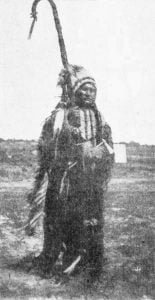The Arapaho and Cheyenne will be considered together. They both belong to the great Algonquian family, and, for a long period, were closely associated. Both were important Plains tribes and bore prominent parts in the early history of that plain along the Front Range of the Rocky Mountains. The Cheyenne ranged far down the plains streams, coming into close contact with pioneer settlers of Northwestern Kansas. The Arapahos did not trouble the white people making homes in Western Kansas. Both tribes lay in wait along the great trails to fall upon the stragglers and the unprotected. They were fierce and daring riders in those days, coming over the deserts in clouds of dust, circling the emigrant train or the trader’s caravan to take it if they could. If the resistance was too much they vanished across the plain like the wind. The Arapahos led the migration from the Algonquian body in the far North. The Cheyenne brought up the rear. They came from what is now Minnesota. Whether they were in league at the time or whether they formed an alliance later cannot be surely said now. They roamed from the Black Hills to the Arkansas. They were always at war with the Pawnees, Utes, and Shoshoni. Until about 1840 they were at constant war with the Sioux, Kiowa, and Comanches. Both the Arapahos and Cheyenne were separated into groups by the treaty of Medicine Lodge in 1867. Southern and Northern Arapahos, and Southern and Northern Cheyenne.
Dunbar was of the opinion that the name Arapaho came from the Pawnee word tirapihu (or carapihu) meaning trader. The Sioux and Cheyennes called the Arapahos Blue-Sky men, and Cloud-men. The import of these appellations is not now known. The Arapahos called themselves Inunaina. They have lost the clan system of organization. In the tribe there are five principal divisions:
- Northern Arapahos, or Sage-brush men, or Red-willow men
- Southern Arapahos, or Southern-men, or Southerners
- Gros Ventres of the Prairie, or White-clay people, or Begging-men. This division is not to be confused with the Gros Ventres of the Upper Missouri.
- Wood-lodge people, or Big Lodge people
- Rock-men

The principal divisions are the Northern and Southern Arapahos.
The Northern Arapahos are still further divided, as follows:
- Forks of the Red River Men
- Bad Pipes
- Greasy Faces
The Southern Arapahos are separated into the following local bands:
- Bad Faces
- Pleasant Men
- Blackfeet
- Wolves
- Watchers
The Cheyenne called themselves Dzi-tsi-is-tas, Our People. The name Cheyenne came from the Sioux designation of this people, that is, from the Sioux word Sha-hi-yena, those who speak a strange language. It has been said that the name came from the French word Chiendogbut this is not so. If the Cheyenne ever had the clan system they have lost it. There are eleven divisions of the tribe:
- Aortas closed by burning.
- Flint People
- Eaters
- Hair Men
- Mangy People, or Scabby People
- Ridge Men
- Sutaio
- Bare Shins
- Poor People
- Ghost Head
- O-mi-sis

These divisions are still further separated, but these minor local bands need not be enumerated here. Among the Plains tribes there were Military Societies or Warrior Organizations. This was well developed in the Cheyenne, who had six such societies. One of these came to be known as the Dog soldiers. It was a large society, and was sometimes supposed to be a regular tribal division. Dog-soldiers are often spoken of in Kansas annals, and the term was not well understood in pioneer times.
The Cheyenne were active in the movement known as the Ghost Dance, of Ghost Dance Religion.
By a treaty made February 18, 1861, the Arapahos and Cheyenne ceded to the Government all their land, and were assigned a reservation outside the limits of Kansas. That part of the cession embraced in Kansas is a tract extending from the Arkansas River to the north boundary.
It is immediately west of the cessions of the Kansas, Osages, and Pawnees, and is some forty miles in width. Its extent north and south is about one hundred and forty-five miles.


